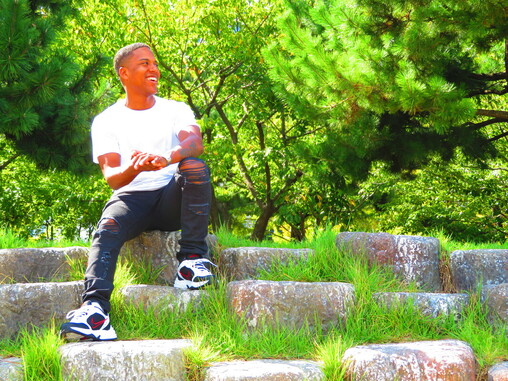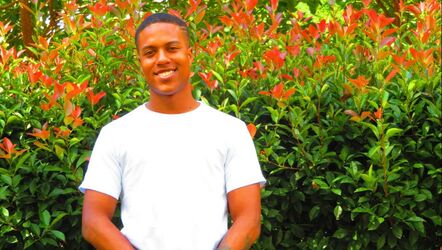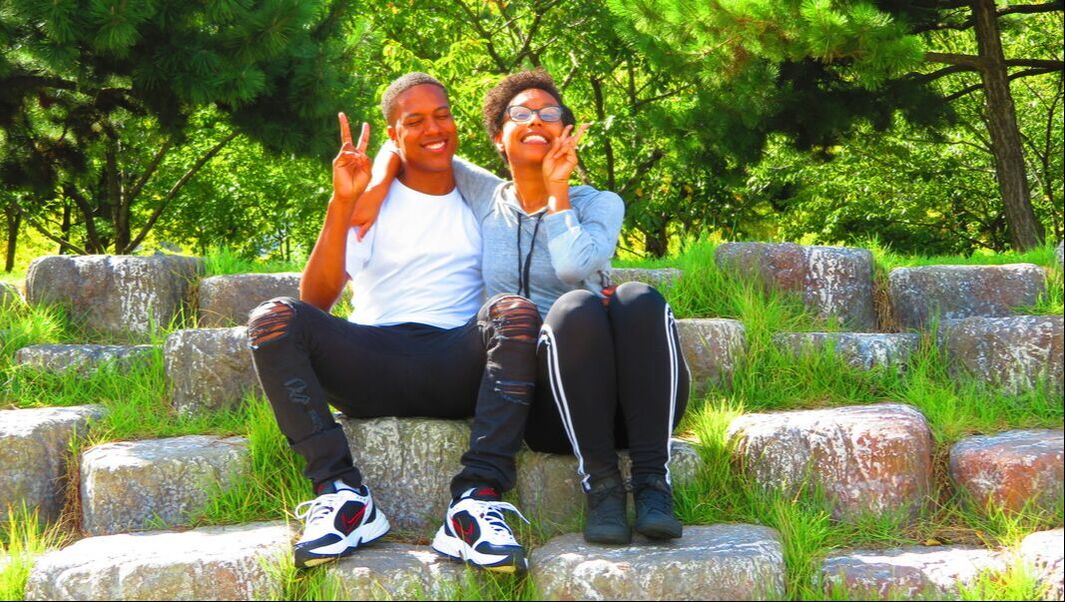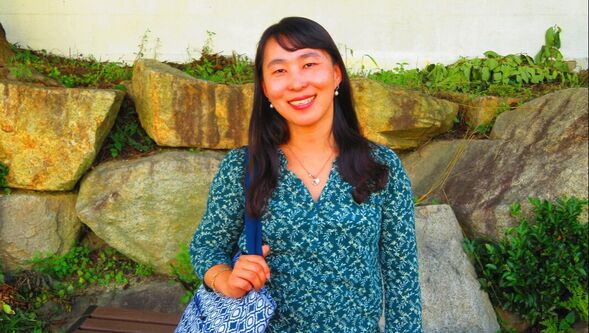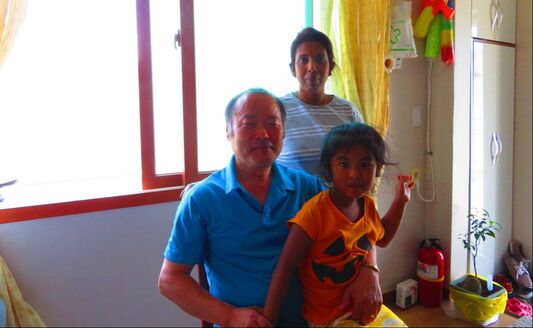|
CONTENT WARNING: Explicit language.
Feeling offended, Ja'Von says, “I’m gay.” With a raised brow, he waits for Min Soo’s response, and for a moment Min Soo is speechless. He examines Ja'Von with a confused look -- Ja'Von is wearing regular jeans and a normal t-shirt; his hair is cut short, and he has toned muscles; he doesn’t have an effeminate twang when he speaks or a flamboyant flare when he moves. “No, you’re not,” Min Soo responds dismissing Ja'Von. “Yes. I am,” Ja'Von confesses. Upon noticing the seriousness of Ja'Von’s tone, Min Soo feels a tinge of guilt and says, “I respect them.” Then, wanting to make sure Ja'Von clearly understands his position on the matter, he adds, “But I hate that shit.” PAUSE. Let me put that together into one statement for you to clearly understand what Min Soo said to Ja'Von: “I respect them, but I hate that shit.” According to the BBC News article, Gay in South Korea, “a survey of under-18 [year olds] in the LGBTQ community discovered that almost half - around 45% - have tried to commit suicide. More than half (53%) have attempted to self-harm.” When Ja'Von tells me this story, I can clearly hear the surprise in his voice. As a listener of Ja'Von’s retelling, I initially thought the surprise was from the clear hypocrisy in Min Soo’s words. But that was only part of it. “Being in Korea, I’ve had such good friends - foreign friends - and I’ve been so comfortable in my bubble that I almost forgot there were people who felt that way. [People] who had those kinds of beliefs,” Ja'Von admitted. It made me wonder...what is life like being black and bisexual living in Busan, South Korea? Ja'Von's Story One day, Ja'Von and his roommate discovered the mystic art of K-pop. This led him down the rabbit-hole of Hallyu culture and sparked an interest in South Korea. Itching for a fresh start and something new, he and his roommate both applied for jobs in Korea, and he landed in Busan in December 2018. Luckily, Ja'Von was able to find a group of friends who made him feel open enough to not only explore his sexuality but feel safe enough to open up about it. “My dad was real hood, you know, like hard. Being gay was not acceptable,” Ja'Von opened up to me. He reflected on the standards that were projected onto him growing up. “In the black community, it’s not okay to be gay. My brother owns a barbershop, and whenever I am there [with other black men] I have to always think, ‘Is my wrist too loose? Did that comment sound gay?’ I’m always critical of myself.” This is a trait that Ja'Von has for everything he does. He said he’s always thinking about how others perceive him and adjusts his behavior to appeal to others. Hence, he’s always hidden the truth of his sexuality. Author Stephanie Dunning writes, referring to Ann Shockley’s novel Loving Her, “It seems to imply that homosexuality is ‘outside’ of blackness and antithetical to ‘authentic’ or ‘true’ blackness” (Dunning, Stefanie K. (2009). Ja'Von identifies himself as bisexual, and he’s currently in a same-sex relationship. Being outside of a community that condemns his sexuality, and having a supportive circle in Korea has allowed Ja'Von to be more open and accepting of himself. So much so that he can publicly confront someone making homophobic comments. His boyfriend, however, has not gained such confidence or comfort in accepting his sexual orientation. Ja'Von’s partner, Ben*, is a twenty-one-year-old Korean native. Similar to Ja'Von’s experience, Ben’s had a hard time exploring his sexuality and is finally understanding who he is and his sexual preference. Their relationship is a first for both of them: Ja'Von’s first serious relationship with a man, and Ben’s first serious relationship, period. “We do small things like touching each other’s hand or brushing my leg against his,” Ja'Von explained about his and Ben’s PDA experience. “What about holding hands?” I asked. Ja'Von gave me a sharp no. “I’m going to leave [Korea one day]. The people I meet here I may not see again in my life, but Ben’s life is here. His friends are here. This is Ben’s home,” he explained. It’s not easy for a Korean man in Korea to claim his sexuality if it doesn’t fall under the heterosexual label. One night, when Ja'Von and Ben were out with their friends, Ja'Von decided to go to McDonald’s, leaving Ben and his friends outside. The streets of downtown Busan are cluttered with people, mostly young, looking for a bar or a club. As Ben and one friend, who identifies as gay and dresses in a more conventionally feminine fashion, stood outside waiting, a group of young Korean girls approached them. They then mocked and teased Ben and his friend even going as far calling them derogatory slurs -- comparable to the “F”-word in the English language. Acceptance from people outside has been challenging, and over the past year it’s been an internal challenge for both Ben and Ja'Von, as well. As Ja'Von explains, coming out isn’t just about telling other people you’re attracted to the same sex. It’s also learning this whole part of yourself that you’ve hidden for so long. “My friends tell me ‘just be yourself.’ I know they’re being nice, but I don’t know how to do that because I don’t even know who I am,” he said. After living for so many years with constant self-criticism and being told it’s not okay to embrace one’s sexuality, it’s not as simple as just saying I’m bisexual. Or I’m gay. Or I’m in love with someone of the same-sex.
*Names changes for privacy and confidentiality
Reference: Queer in Black and White: Interraciality, Same-Sex Desire, and Contemporary [...] - Stefanie K. Dunnin
4 Comments
After working as an English teacher for the past three years, Kinam decided it was time to brush up on her English skills. Taking the chance to apply for a specialized English educator’s training at Cheongju National University, she entered the program in the Fall of 2004. But little did she know, this would be a moment that would change her life forever. What started as a professional student-teacher relationship with her Canadian mentor quickly blossomed into a formidable friendship. Upon the completion of her six-month training, her trainer became her beau. It’s been fifteen years since that serendipitous encounter, and now they share a life together in Busan with two adorable sons, ages seven and three. Just like any relationship, the life they led and continue living isn’t one without complications, and the issues that arise for a Korean woman married to a white-Canadian man in Korea can be a little...complex. At the start of their relationship, Kinam and her husband, Colin, had to overcome the obstacles that existed outside of themselves. When she first introduced the idea of dating a foreigner to her parents, they had more than some qualms. “My parents were completely against the idea,” Kinam told me, “my mother advised me not to get too close.” Sadly, it didn’t seem to just be her parents that had issues with it. Early on in their relationship, there was an instance when Kinam and Colin realized just how unwelcomed their interracial and intercultural relationship was in a homogeneous country such as South Korea. A normal ride on the subway quickly turned for the worst as an elder Korean man turned to Colin and decided to hurl some explicit insults his way. Being a newcomer to Korea, Colin didn’t understand what the man was saying, but Kinam did. “Older Korean people still have a distorted view of foreign men,” she explained to me. “They associate [white] men with American men from during the war and they think of Korean women prostituting [to the American army-men].” Kinam decided she wasn’t going to let someone disrespect her and her man. “We were so close to physically fighting,” she continued, “but we got off at the next stop to calm down. I was so upset.”
The conservative and nationalistic views of older Korean natives took their toll on Kinam and Colin. For two years, they lived separately, but Colin was ready to live closer to Kinam. She enjoyed the idea, but, “Now things have changed, but back then to live with someone before marriage, AND he’s a foreigner...there would be some big problems. That was an absolute no.” Kinam was ready to move forward in her relationship but wasn’t going to get married simply to live together. Luckily, at the time she was looking into graduate programs in Australia, so they ventured out together: she as a graduate student, and he as a teacher. During their year in Australia, Colin proposed. After meeting Colin, Kinam’s parents warmed to the idea of their relationship, and they’ve been married for the past decade. They’ve conquered the insulting comments and disapproving looks, but they weren’t prepared for the crisis to enter their home. Kinam and Colin’s firstborn son, Liam, now 7, has recently started the first grade. Initially, Kinam and her husband planned to move to Canada, and is the custom, their son has his father’s last name. His middle name is his mother’s maiden name, Choi*. In Korea, people go by their family name first, and then their given name. So Liam’s name is O’Donnell* Liam Choi. Distinctively different from all the other children. He has dealt with mild bullying with children calling him a foreigner and telling him he’s not Korean. These issues have seemed to have moderately affected Liam’s perception of his identity. “He came home and said his name is Liam Choi. Not O’Donnell,” Kinam admitted solemnly. Liam’s premature identity crisis reminded me of my experience growing up in a Trinidadian household, and no one around me being of the same home culture. On top of that, my parents are of mixed race. It was hard to make friends at such a young age, and even in my adolescence after befriending a diverse crowd, the insecurity from my childhood still festered within me. “When did you finally feel confident in yourself and accept who you are?” Kinam asked me obviously worried about the experience of her own child. “Like a few years ago,” I said honestly with a slight chuckle. “But I think it builds character and really makes you appreciate the differences in yourself and your family.” Although the family wants to move back to the Toronto area, it seems quite difficult. They are anticipating the sticky situations and complicated questions that come with being a mixed-race family in South Korea. Kinam recently returned from Canada, leaving her boys and her husband to relish in the chance to spend some quality time with his family. She shared with me a variety of warming memories and adorable pictures of her two sons with her husband. Their family is a picture of adoration, but there are layers to peel back: A battle was won to make their family happen; a daily struggle they will have to continue to confront, but for their kind of love...it’s worth fighting for. *names changed for privacy and confidentiality I walk past the busy people rushing to the marketplace on this blistering sunny Sunday morning anticipating my meeting with Achala, a kind woman I met serendipitously at the bus stop near my house. That fateful morning, I wandered into a nearby 7/11 convenience store for breakfast before heading to work, and as I stepped out I saw the brown-skinned woman pass by watching me with the same curious look I gave her. I believe in Korea, most non-Koreans look out for other non-Koreans, and when we see each other there is a mutual warm feeling that there is someone else who is foreign like them. With a gentle smile and nod of my head, she reciprocated my friendly “hello” and asked, “Where are you from?” “America,” I answered. Her lips curled into a tender smile. In return, I asked if she was also from the states, to which she answered, “No. Sri Lanka.” The more we spoke, I realized that she did not speak much English, and she realized I did not speak much Korean, but the beauty of this blended world is that we can blend language and communicate. “Your house...yogi?” she asked mixing English and Korean. “Nae,” I responded, “House yogiyo,” I turned my head in the direction of my apartment and pointed with my chin. “Chonun yeongeo seonsaengnim,” I answered explaining I was an English teacher. “You, too?” I asked inquiring of what prompted this Sri Lankan woman to move to this country so far away. “Aniyo...hangook marry. Hangook husband.” At her answer, my eyes widened with intrigue. It was one of the most fascinating encounters I had in all of my three years in Korea. I had lived in this neighborhood all of those years, and never seen another foreigner who wasn’t a teacher. Here I was, this Trini-American black woman, talking to a Sri Lankan woman at a bus stop in Korea, mixing English and Korean to have a conversation. I couldn’t help but ask to meet her again, and out of her motherly kindness, she agreed. Achala stood at the end of the street waving for me to see her. She held onto the tiny hand of her precious daughter and smiled. Through the market, we walked passing by the mixed smells of fresh fruit, rich dirt on vegetable roots, and fish hung to dry. On the roof of one of the smaller complexes was a metal gate surrounding a corridor of steep cement steps leading to an apartment. “Yogi,” Achala exclaimed pointing at her home at the top of the concrete building. Her daughter wore a bright orange shirt complimenting the bronze hues of her skin and highlighted the pathway up to the steps and to their home. I slipped off my sandals and watched in awe as I hardly ever get the chance to see inside the homes of others living in Korea, especially average everyday families. Directly across from the entrance was a plethora of family photos displayed on the wall. To the left were two doors -- one closed; one open-- and inside the opened room was a good-natured older gentleman. He made his way through the doorway and into the common area which was a combination of their kitchen and dining area. “Anyeonghaseyo,” I brightly smiled and lowered my head in traditional Korean fashion to greet the man. “Hello! Welcome!” he greeted me warmly and reached out to shake my hand in an American manner. My brow raised in curiosity and prompted me to ask, “Do you speak English?” “Chogeum (a little),” he responded in Korean. “My English speaking chogeum,” he explained. “Also, my Korean speaking chogeum,” I replied and we both shared a laugh at our own expense, but it was comforting that we were all different people willing to share a conversation without letting language limit us. Achala prepared some juice for herself, her husband, her daughter, and I as her husband pulled out a speech translator for us to participate in this multicultural discourse. The Interview Achala has been living in Korea for about sixteen years having moved here in 2003 for work. When asked about Sri Lanka, she responded that life in Sri Lanka was hard and she really enjoys her life in Korea. To be very honest, I expected some cultural dissonance; however, she says she loves everything about Korea. When I inquired about any difficulty in Korea due to prejudice because she is a foreigner, she explained she never experienced any discrimination. Rather, the most difficult thing she had to overcome due to cultural difference was a traditional service during two major Korean holidays. Achala and her husband explained it was difficult for her to become accustomed to the traditional charye and seongmyo services Korean people usually perform on Chuseok, Korean Thanksgiving, and Seollal,New Years. These customs require setting up a meal for the family’s ancestors and visiting family graves. In these settings, one must perform a ritual of bowing multiple times in honor and reverence of those who have come before. It’s also customary to clean the graves of the ancestors and spend much time eating with family (I had the fortune of being invited to a Korean friend’s house for Chuseok one year, and it was an occasion unlike anything I had experienced before). Although these customs were hard to adjust to, after living a happy life with her family, Achala says it’s okay now. She and her husband, Byeong Tae, have been married for seven years and have their daughter who is six years old -- who they refer to as “the baby” which I think is adorable and can be attributed to their loving family dynamic. Achala has two sisters and her father who live back in her native land, Sri Lanka, but when I asked her about her family, she pointed to one of the pictures on the wall and said, “That’s my family.” The picture was of the baby’s first birthday party. Achala and Byeong Tae wore beautiful hanbok, a traditional Korean dress. The hanbok was delicately designed and displayed vivid variants of reds and pinks. They each cupped their daughter in their hands to lift her up together to be the center of the photo. Behind them stood about fifteen people, relatives from Byeong Tae’s side of the family, and those were the people Achala called family. I had come to learn that her mother had passed away, and her father was in his old age. With a smile, she opened her Facebook profile and showed me pictures of her two sisters and their children. Whenever the subject of life in Sri Lanka was brought up, Achala’s responses became a little colder, but I didn’t want to press her to find out why. Her husband graciously invited me to stay for lunch, and they cooked a delicious meal of spicy braised chicken and potatoes with rice. It was a very Korean meal, and served in Korean fashion, so out of curiosity I asked, “Do you also cook Sri Lankan meals?”
here in Korea. Byeong Tae chimed in and said none of her Sri Lankan friends are here in Korea.
“Are there other Sri Lankan people living in this city?” I asked. “Mostly men for industrial jobs, and in parts of the city that are far from here,” they explained. My eyes lowered, and at that moment I felt a bit of sadness. As a foreigner --who genuinely likes Korea -- I know it can be a lonely experience when no around you is completely like you…Even if they’re nice, loving, and empathetic. The corner of my mouth quirked up, and I said, “I’ll be your friend.” |
Services |
Author |
|
